As an avid coin collector and history buff, I am always fascinated by the designs and artistry of coins and tokens, their countries of origin, and the stories about them. The purpose of this article is to explore one of the most fascinating tokens ever made – Saint Lambert’s Cathedral Communion Tokens, also known as Memento Mori tokens. In order to fully appreciate these beautiful and rare tokens, one needs to know a little bit about church history, what the symbols on the tokens represent, and why they were made. So let’s dive in!
Why Were Communion Tokens Made?
In the mid 1500’s, French Huguenots and Scottish Presbyterians began implementing the use of communion tokens, known in old French as méreau or méreaux. The word méreau comes from the Latin word “merere”, meaning to deserve or deserving.
These tokens were used in churches as a symbol that a parishioner needed to pass a personal spiritual examination of their life prior to taking communion. This was an act of devotion and to heed the warning written in the book of 1 Corinthians 11:23-31, which states: “For I received from the Lord what I also passed on to you: The Lord Jesus, on the night he was betrayed, took bread, and when he had given thanks, he broke it and said, “This is my body, which is for you; do this in remembrance of me.” In the same way, after supper he took the cup, saying, “This cup is the new covenant in my blood; do this, whenever you drink it, in remembrance of me.” For whenever you eat this bread and drink this cup, you proclaim the Lord’s death until he comes. Therefore, whoever eats the bread or drinks the cup of the Lord in an unworthy manner will be guilty of sinning against the body and blood of the Lord. A man ought to examine himself before he eats of the bread and drinks of the cup. For anyone who eats and drinks without recognizing the body of the Lord eats and drinks judgment on himself. That is why many among you are weak and sick, and a number of you have fallen asleep. But if we judged ourselves, we would not come under judgment.”
Even though communion tokens were used as a means to reflect on the eventuality of death, ministers of the gospel were also responsible to encourage their congregation and share the positive aspects of the faith as well as the promises that a follower of Christ is destined to inherit.
Latin – The Language of The Church
During the period Saint Lambert communion tokens were used, the universal language of the Roman Catholic church was Latin. In Latin, there are three very important phrases that were instrumental to the faith, one is “gratia estis salvati” which means “By grace you are saved”. This comes from the book of Ephesians 2:8-9 which says: “For it is by grace you have been saved, through faith—and this is not from yourselves, it is the gift of God—not by works, so that no one can boast.” The second phrase is “donum dei vita aeterna per Iesum Christum”, which means “the gift of god is eternal life through Jesus Christ”. This comes from the book of Romans 6:23, which says: “For the wages of sin is death, but the gift of God is eternal life in Christ Jesus our Lord.”
The third phrase, which likely had some influence in the design of the tokens is “Absorpta est mors in Victoria”, which means “Death has been swallowed up in victory”. This phrase comes from the book of 1 Corinthians 15:54-55, which says: When the perishable has been clothed with the imperishable, and the mortal with immortality, then the saying that is written will come true: “Death has been swallowed up in victory”. “Where, O death, is your victory?” Where, O death, is your sting?”
 Before taking communion, the elders of the church would interview each person and distribute the tokens to those who prepared their hearts to receive it. Prior to taking the communion elements (typically bread and wine), the believer would give the token to the minister. In addition to being used for communion, these tokens were also likely used during the feast day celebrations commemorating the anniversary of St. Lambert’s remains being placed in the cathedral at Liège.
Before taking communion, the elders of the church would interview each person and distribute the tokens to those who prepared their hearts to receive it. Prior to taking the communion elements (typically bread and wine), the believer would give the token to the minister. In addition to being used for communion, these tokens were also likely used during the feast day celebrations commemorating the anniversary of St. Lambert’s remains being placed in the cathedral at Liège.
At least four out of the five Saint Lambert tokens were made while Maximilian Henry of Bavaria (1621 – 1688) was the Bishop of Liège. In 1650, he was named Archbishop-Elector of Cologne, Bishop of Hildesheim and Bishop of Liège. He worked throughout his career with the French to limit the authority of the Holy Roman Emperor, and participated in the Franco-Dutch War on the opposite side from the Empire.
The Prince-Bishopric of Liège or Principality of Liège was an ecclesiastical principality (territory ruled by a bishop as a prince) of the Holy Roman Empire that was situated for the most part in present-day Belgium. It was an Imperial Estate, so the bishop of Liège, as its prince, had a seat and a vote in the Imperial Diet (the deliberative body of the Holy Roman Empire). The Prince-Bishopric of Liège should not be confused with the Diocese of Liège, which was larger and over which the prince-bishop exercised only the usual responsibilities of a bishop. For more information on Maximilian Henry of Bavaria, visit: https://en.wikipedia.org/wiki/Maximilian_Henry_of_Bavaria For more information on The Prince-Bishopric of Liège or Principality of Liège visit: https://en.wikipedia.org/wiki/Prince-Bishopric_of_Li%C3%A8ge
The History of Lambert of Maastricht “Saint Lambert” (c 635-c 700)
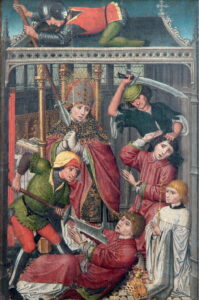 Lambert of Maastricht, commonly referred to as Saint Lambert (c. 636 A.D. – c. 705 A.D.) was born in Maestricht, a city in the province of Flanders (now known as the Netherlands). He was the bishop of Maastricht-Liège from about 670 A.D. until his death. He is described by early biographers as “a prudent young man of pleasing looks, courteous and well-behaved in his speech and manners, well-built, strong, a good fighter, clear-headed, affectionate, pure and humble and fond of reading. As a young man he wrought miracles, one day bringing forth a spring to quench the thirst of some workers building a church, and in this way he became known to everyone in the city.”
Lambert of Maastricht, commonly referred to as Saint Lambert (c. 636 A.D. – c. 705 A.D.) was born in Maestricht, a city in the province of Flanders (now known as the Netherlands). He was the bishop of Maastricht-Liège from about 670 A.D. until his death. He is described by early biographers as “a prudent young man of pleasing looks, courteous and well-behaved in his speech and manners, well-built, strong, a good fighter, clear-headed, affectionate, pure and humble and fond of reading. As a young man he wrought miracles, one day bringing forth a spring to quench the thirst of some workers building a church, and in this way he became known to everyone in the city.”
While few details of St. Lambert’s life are known, historians and religious scholars have agreed that he was murdered as a result of admonishing the Merovingian Duke Pepin II (Pepin of Herstal) for adultery with a noblewoman named Alpaida. This illicit union between Pepin II and Alpaida later led to the birth of Charles Martel (“The Hammer” 688 –741) and Childebrand I (678–751). Charles Martel took over after his father’s death and went on to end the Muslims’ inroads into Western Europe at the Battle of Tours, and become the grandfather of Charlemagne (742–814), the first Holy Roman Emperor.
The admonishment issued by Saint Lambert humiliated Pepin and Alpaida, so they had him murdered. St. Lambert is said to have been killed with a javelin during mass in Liege’s Chapel of Saints Cosmas & Damian by soldiers under the command of Alpaida’s family. Saint Lambert’s two nephews, Peter and Audolet, were also killed defending their uncle.
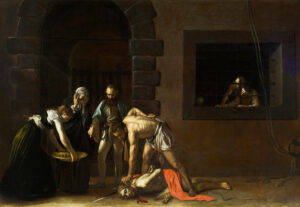 Many believe that Saint Lambert’s deep conviction to defend Holy matrimony stemmed from the example set by John the Baptist when he confronted King Herod. “Now Herod had arrested John and bound him and put him in prison because of Herodias, his brother Philip’s wife, for John had been saying to him: “It is not lawful for you to have her.” Herod wanted to kill John, but he was afraid of the people, because they considered John a prophet. On Herod’s birthday the daughter of Herodias danced for the guests and pleased Herod so much that he promised with an oath to give her whatever she asked. Prompted by her mother, she said, “Give me here on a platter the head of John the Baptist.” The king was distressed, but because of his oaths and his dinner guests, he ordered that her request be granted and had John beheaded in the prison. His head was brought in on a platter and given to the girl, who carried it to her mother. John’s disciples came and took his body and buried it.” Matthew 14:3-14.
Many believe that Saint Lambert’s deep conviction to defend Holy matrimony stemmed from the example set by John the Baptist when he confronted King Herod. “Now Herod had arrested John and bound him and put him in prison because of Herodias, his brother Philip’s wife, for John had been saying to him: “It is not lawful for you to have her.” Herod wanted to kill John, but he was afraid of the people, because they considered John a prophet. On Herod’s birthday the daughter of Herodias danced for the guests and pleased Herod so much that he promised with an oath to give her whatever she asked. Prompted by her mother, she said, “Give me here on a platter the head of John the Baptist.” The king was distressed, but because of his oaths and his dinner guests, he ordered that her request be granted and had John beheaded in the prison. His head was brought in on a platter and given to the girl, who carried it to her mother. John’s disciples came and took his body and buried it.” Matthew 14:3-14.
After St. Lambert’s martyrdom, his body was entombed at Maestricht. Later, it was moved to Liège, in the Eastern part of modern Belgium, where his relics are honored to this day. For more information on Saint Lambert, visit: https://en.wikipedia.org/wiki/Lambert_of_Maastricht
St. Lambert Token’s Design Elements – There’s More Than What Meets The Eye!
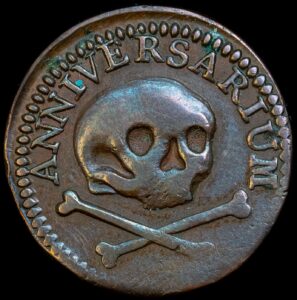 Most will agree that the design of Saint Lambert communion tokens are quite striking and mysterious. The image of a skull and crossbones on the obverse might appear to some as a symbol of the occult or some affiliation with the SS of Nazi Germany. In reality, the skull and crossbones images are known as “Memento Mori”, which is a Latin term for “Remember death” or “remember you must die”.
Most will agree that the design of Saint Lambert communion tokens are quite striking and mysterious. The image of a skull and crossbones on the obverse might appear to some as a symbol of the occult or some affiliation with the SS of Nazi Germany. In reality, the skull and crossbones images are known as “Memento Mori”, which is a Latin term for “Remember death” or “remember you must die”.
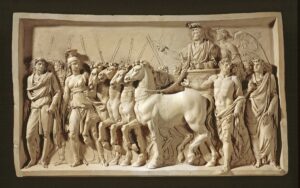 In ancient Rome after a major military victory, the triumphant general, known as a “triumphator” would be cloaked in royal purple and ride in a golden chariot drawn by four horses. He was paraded through the streets in a grand procession with his army, prisoners, and the spoils of war. There was not a more coveted honor. The general was idolized, viewed as divine by his troops and the public alike. But riding in the same chariot, standing just behind the worshipped general, was a slave. The slave’s sole responsibility for the entirety of the procession was to whisper in the general’s ear continuously, “Respice post te. Hominem te esse memento. Memento mori!” “Look behind you. Remember you are human. Remember you must die!” The slave served to remind the victor at the peak of glory, this god-like adoration would soon end, while the truth of his mortality remained. For more on the history of Roman processions, visit: https://www.worldhistory.org/Roman_Triumph/
In ancient Rome after a major military victory, the triumphant general, known as a “triumphator” would be cloaked in royal purple and ride in a golden chariot drawn by four horses. He was paraded through the streets in a grand procession with his army, prisoners, and the spoils of war. There was not a more coveted honor. The general was idolized, viewed as divine by his troops and the public alike. But riding in the same chariot, standing just behind the worshipped general, was a slave. The slave’s sole responsibility for the entirety of the procession was to whisper in the general’s ear continuously, “Respice post te. Hominem te esse memento. Memento mori!” “Look behind you. Remember you are human. Remember you must die!” The slave served to remind the victor at the peak of glory, this god-like adoration would soon end, while the truth of his mortality remained. For more on the history of Roman processions, visit: https://www.worldhistory.org/Roman_Triumph/
Memento mori symbols can be seen on some Roman and early Christian tombs, the Knights Templar used it around the 13th century, and even pirates used variations of it on their flags.
Whether these tokens were used to participate in communion, anniversary feasts, attendance at funerals, or other church functions, the message they convey is that we are all mortal and need to consider where we will spend eternity.
The Inspiration Behind The Design
To get a better feel of what may have gone through the mind of the designers and die engravers of these tokens, you have to remember that these were specifically made for the Cathedral of Saint Lambert in Liège about a thousand years after the saint’s death. The flame symbols on the reverse of four of the five varieties have biblical significance and most likely represent the life transforming power of the Holy Spirit. Jesus told his disciples: “And, behold, I send the promise of my Father upon you: but tarry ye in the city of Jerusalem, until ye be endued with power from on high.” (Luke 24:49) Then the book of Acts 2:1-3 states: “And when the day of Pentecost was fully come, they were all with one accord in one place. And suddenly there came a sound from heaven as of a rushing mighty wind, and it filled all the house where they were sitting. And there appeared unto them cloven tongues like as of fire, and it sat upon each of them.”
 The flame images may also represent Moses’s encounter with the burning bush found in Exodus 3:1-6. “Now Moses was tending the flock of Jethro his father-in-law, the priest of Midian, and he led the flock to the far side of the wilderness and came to Horeb, the mountain of God. There the angel of the Lord appeared to him in flames of fire from within a bush. Moses saw that though the bush was on fire it did not burn up. So Moses thought, “I will go over and see this strange sight—why the bush does not burn up.” When the Lord saw that he had gone over to look, God called to him from within the bush, “Moses! Moses!” And Moses said, “Here I am.” “Do not come any closer,” God said. “Take off your sandals, for the place where you are standing is holy ground.” Then he said, “I am the God of your father, the God of Abraham, the God of Isaac and the God of Jacob.” At this, Moses hid his face, because he was afraid to look at God.”
The flame images may also represent Moses’s encounter with the burning bush found in Exodus 3:1-6. “Now Moses was tending the flock of Jethro his father-in-law, the priest of Midian, and he led the flock to the far side of the wilderness and came to Horeb, the mountain of God. There the angel of the Lord appeared to him in flames of fire from within a bush. Moses saw that though the bush was on fire it did not burn up. So Moses thought, “I will go over and see this strange sight—why the bush does not burn up.” When the Lord saw that he had gone over to look, God called to him from within the bush, “Moses! Moses!” And Moses said, “Here I am.” “Do not come any closer,” God said. “Take off your sandals, for the place where you are standing is holy ground.” Then he said, “I am the God of your father, the God of Abraham, the God of Isaac and the God of Jacob.” At this, Moses hid his face, because he was afraid to look at God.”
 All five varieties of Saint Lambert communion tokens have a skull and crossbones on the obverse. However, on the obverse of the first variety dated to 1635 you see the typical skull and crossbones, only here the skull is superimposed over the crossbones in a saltire or Saint Andrews cross pattern. This is significant as early church historians state that St. Andrew was sentenced to death by crucifixion by the Romans in the city of Patras, Greece in AD 60 and asked to be crucified on a diagonal cross as he felt unworthy to die on the same shape of cross as Jesus. Tradition also says that the Romans rotated the traditional cross onto its side as an insult. For more information on Andrew the Apostle, visit: https://en.wikipedia.org/wiki/Andrew_the_Apostle
All five varieties of Saint Lambert communion tokens have a skull and crossbones on the obverse. However, on the obverse of the first variety dated to 1635 you see the typical skull and crossbones, only here the skull is superimposed over the crossbones in a saltire or Saint Andrews cross pattern. This is significant as early church historians state that St. Andrew was sentenced to death by crucifixion by the Romans in the city of Patras, Greece in AD 60 and asked to be crucified on a diagonal cross as he felt unworthy to die on the same shape of cross as Jesus. Tradition also says that the Romans rotated the traditional cross onto its side as an insult. For more information on Andrew the Apostle, visit: https://en.wikipedia.org/wiki/Andrew_the_Apostle
The Five Types of Saint Lambert’s Communion Tokens
All of the Saint Lambert tokens were likely minted on a screw press and made by local blacksmiths. Keep in mind that there are a variety of die variations for each issue. Here are some general details of each that may be helpful:
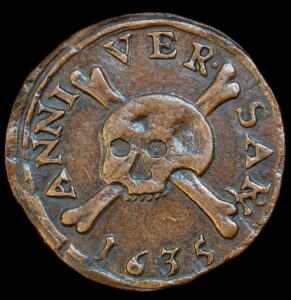 Token #1 Obverse: This is the first year of issue for the Memento Mori variety of communion tokens and by far the rarest. On this type, the bones are larger and interrupt the legend. The skull has a single triangular nostril, six teeth and no lower jaw. Skull faces to the left superimposed on a saltire cross of bones. The skull also has two curious indentions that likely represent wounds or skull damage.
Token #1 Obverse: This is the first year of issue for the Memento Mori variety of communion tokens and by far the rarest. On this type, the bones are larger and interrupt the legend. The skull has a single triangular nostril, six teeth and no lower jaw. Skull faces to the left superimposed on a saltire cross of bones. The skull also has two curious indentions that likely represent wounds or skull damage.
Legend Description: ANNI. VER. SARY (Latin for Anniversary) Note that the “R” and “Y” in ANNIVERSARY are combined as one letter.
Date: 1635
Composition: Likely Bronze
 Token #1 Reverse: A bishop’s miter (a headdress worn by Roman Catholic bishops) in front of a crozier or crosier (a hooked staff carried by a bishop as a symbol of pastoral office) and a sword. Here is an example: https://en.wikipedia.org/wiki/Crosier
Token #1 Reverse: A bishop’s miter (a headdress worn by Roman Catholic bishops) in front of a crozier or crosier (a hooked staff carried by a bishop as a symbol of pastoral office) and a sword. Here is an example: https://en.wikipedia.org/wiki/Crosier
Legend Description: ECCLE.SIÆ.LEOD (Latin for “Of The Church Liège”) The Latin character “Ӕ” is used instead of AE for ECCLESIӔ.
Reference: Renesse Plate 71 #2, O.L. Eklund #82
Note: This is the rarest of all the varieties.
 Token #2 Obverse: A somewhat crude skull without a lower jaw looking left with two crossed bones underneath. Skull shows two nostrils and four teeth. Planchets tend to show multiple cracks.
Token #2 Obverse: A somewhat crude skull without a lower jaw looking left with two crossed bones underneath. Skull shows two nostrils and four teeth. Planchets tend to show multiple cracks.
Legend Description: ANNIVERSAR (Latin for ”Anniversary”) Under the crossed bones
Date: 1653
Composition: Likely copper
 Token #2 Reverse: Tongues of fire each set above and below two crossed bones. A single dot is present between the ends of the bones and double dots after LEODI. This variety tends to look crude even in high grades.
Token #2 Reverse: Tongues of fire each set above and below two crossed bones. A single dot is present between the ends of the bones and double dots after LEODI. This variety tends to look crude even in high grades.
Legend Description: ECCLESIÆ LEODI (Latin for “Of The Church Liège”) The Latin character “Ӕ” is used instead of AE for ECCLESIӔ.
Reference: Renesse Plate 71 #3 O.L. Eklund #83
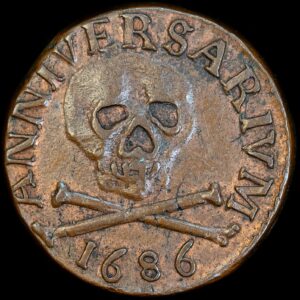 Token #3 Obverse: Detailed full skull facing forward with crossed bones underneath and date below the bones. A rope design around the outer edge of the planchet.
Token #3 Obverse: Detailed full skull facing forward with crossed bones underneath and date below the bones. A rope design around the outer edge of the planchet.
Legend Description: ANNIVERSARIVM (Latin for Anniversary)
Date: 1686
Composition: Likely copper
Note: Later versions of this token have a large die crack from the right side of the skull that obscures the “R” in ANNIVERSARIVM. The crack resembles a skull with a snorkel in his mouth. See last image.
 Token #3 Reverse: Tongues of fire each set above and below two crossed bones. A double dot is typically present after “ECCLESI :”, before “:LEODI” and after the “I” in “LEODI:”. The word “LEODI” is oriented upside down. A rope design may be present around the outer perimeter of the planchet.
Token #3 Reverse: Tongues of fire each set above and below two crossed bones. A double dot is typically present after “ECCLESI :”, before “:LEODI” and after the “I” in “LEODI:”. The word “LEODI” is oriented upside down. A rope design may be present around the outer perimeter of the planchet.
Legend Description: ECCLESI LEODI (Latin for “The Church of Liège”)
Reference: Renesse Plate 71 #4, O.L. Eklund #84
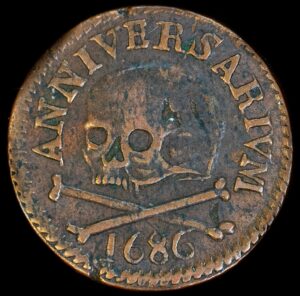 Token #4 Obverse: Detailed skull without lower jaw facing left with crossed bones underneath and date below the bones. Eight teeth. A rope design around the outer edge of the planchet.
Token #4 Obverse: Detailed skull without lower jaw facing left with crossed bones underneath and date below the bones. Eight teeth. A rope design around the outer edge of the planchet.
Legend Description: ANNIVERSARIVM (Latin for Anniversary)
Date: 1686
Composition: Likely bronze
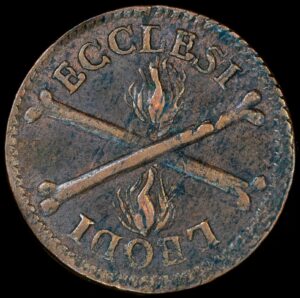 Token #4 Reverse: Tongues of fire each set above and below two crossed bones. No dots are used between the words. The word “LEODI” is oriented upside down. A rope design may be present around the outer perimeter of the planchet.
Token #4 Reverse: Tongues of fire each set above and below two crossed bones. No dots are used between the words. The word “LEODI” is oriented upside down. A rope design may be present around the outer perimeter of the planchet.
Legend Description: ECCLESI LEODI (Latin for “The Church of Liège”)
Reference: Renesse Plate 72 #5, O.L. Eklund #85
 Token #5 Obverse: A striking skull without a lower jaw looking right with two crossed bones underneath. Six upper teeth. Some examples may have reeding around the perimeter. The bottom area under the bones is typically weakly struck.
Token #5 Obverse: A striking skull without a lower jaw looking right with two crossed bones underneath. Six upper teeth. Some examples may have reeding around the perimeter. The bottom area under the bones is typically weakly struck.
Legend Description: ANNIVERSARIUM (Latin for ”Anniversary”) Under the crossed bones
Date: Not shown – Circa 1700
Composition: Copper
 Token #5 Reverse: Tongues of fire each set above and below two crossed bones. A single dot is present after “ECCLESI” and after “LEODI”. The word “LEODI” is oriented right side up. The upper portion of the legend and dots are typically weakly struck.
Token #5 Reverse: Tongues of fire each set above and below two crossed bones. A single dot is present after “ECCLESI” and after “LEODI”. The word “LEODI” is oriented right side up. The upper portion of the legend and dots are typically weakly struck.
Legend Description: ECCLESI LEODI (Latin for “The Church of Liège”)
Reference: Renesse Plate 72 #6, O.L. Eklund #86
Note: This variety is considered the most common.
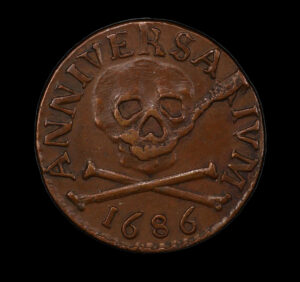 This 1686 variety with the die crack I refer to as the “Davy Jones variety“. The die crack resembles a skull with a snorkel in his mouth.
This 1686 variety with the die crack I refer to as the “Davy Jones variety“. The die crack resembles a skull with a snorkel in his mouth.

This famous and very rare map is from the period when Saint Lambert Communion Tokens were minted and is known as the Leo Belgicus (The Lion of Belgium) map. It was created by Claes Jansz Visscher in 1650. It shows the 15 governors of the Netherlands and commemorates the Dutch independence from Spain. If you look closely, you can see the city of Liège on the raised right forearm of the lion and the city of Maastricht, where Saint Lambert was born directly above.
References:
- Renesse-Breidbach, Clément W. de: Histoire numismatique de l’évêché et principauté de Liège 1831 (Numismatic History of the Bishopric and Principality of Liège by: Renesse-Breidbach, Clément W. Published in 1831) ‘Renesse-Breidbach, Clément W. de: Histoire numismatique de l’évêché et principauté de Liège’, Bild 387 von 406 | MDZ (digitale-sammlungen.de)
- In Revue Belge de Numismatique 1850. Published in Brussels in 1850, pages 124-126
- In Revue Belge de Numismatique 1875. Published in Brussels 1875, pages 252-254
- To view digital copies of “In Revue Belge de Numismatique” for 1850 or 1875, visit the Royal Numismatic Society of Belgium at http://www.numisbel.be/inhoudstafel.htm
- Charity Tokens of the Netherlands by O.P. Eklund published in 1948 by the American Numismatic Association.
- Les monnaies de la principauté de Liège, Volume IV. Monnaies particulières, jetons, médailles, méreaux, trébuchets Jean-Luc Dengis (The coins of the Principality of Liège: From Notger to Henry of Guelders (972-1274) By Jean-Luc Dengis)
- Medals of Belgium https://www.lodenpenningen-belgie.be/447632879/447714231
- Jetons Et Méreaux – Depuis Louis IX Jusqu’a La Fin Du Consulat de Bonaparte by Rollin & Feuardent (published in Paris 1915) See items 14586-14590 in the catalog. Here is the link to the imaged catalog: https://gallica.bnf.fr/ark:/12148/bpt6k378629f/f314.item
- Beschreibung der bekanntesten Kupfermünzen. Bände I – VI und Registerband.( Faksimiledruck der Erstausgabe aus dem Jahre 1858 ) “Description of the most famous copper coins” By Neumann, J. Kupfermünzen 1858 Published by Leipzig, 1966
- “Essai D’Un Dictionnaire Descriptif General Des Mereaux Belges” (Essay on a General Descriptive Dictionary of Belgian Tokens) Numismatic Pocket #29, By: Jean Justice, republished in 1982 (pp. 16-17, nos. 40-44)
If you have any questions regarding Saint Lambert tokens, please contact Sean Scott at Sean@CommodoreCoins.com.

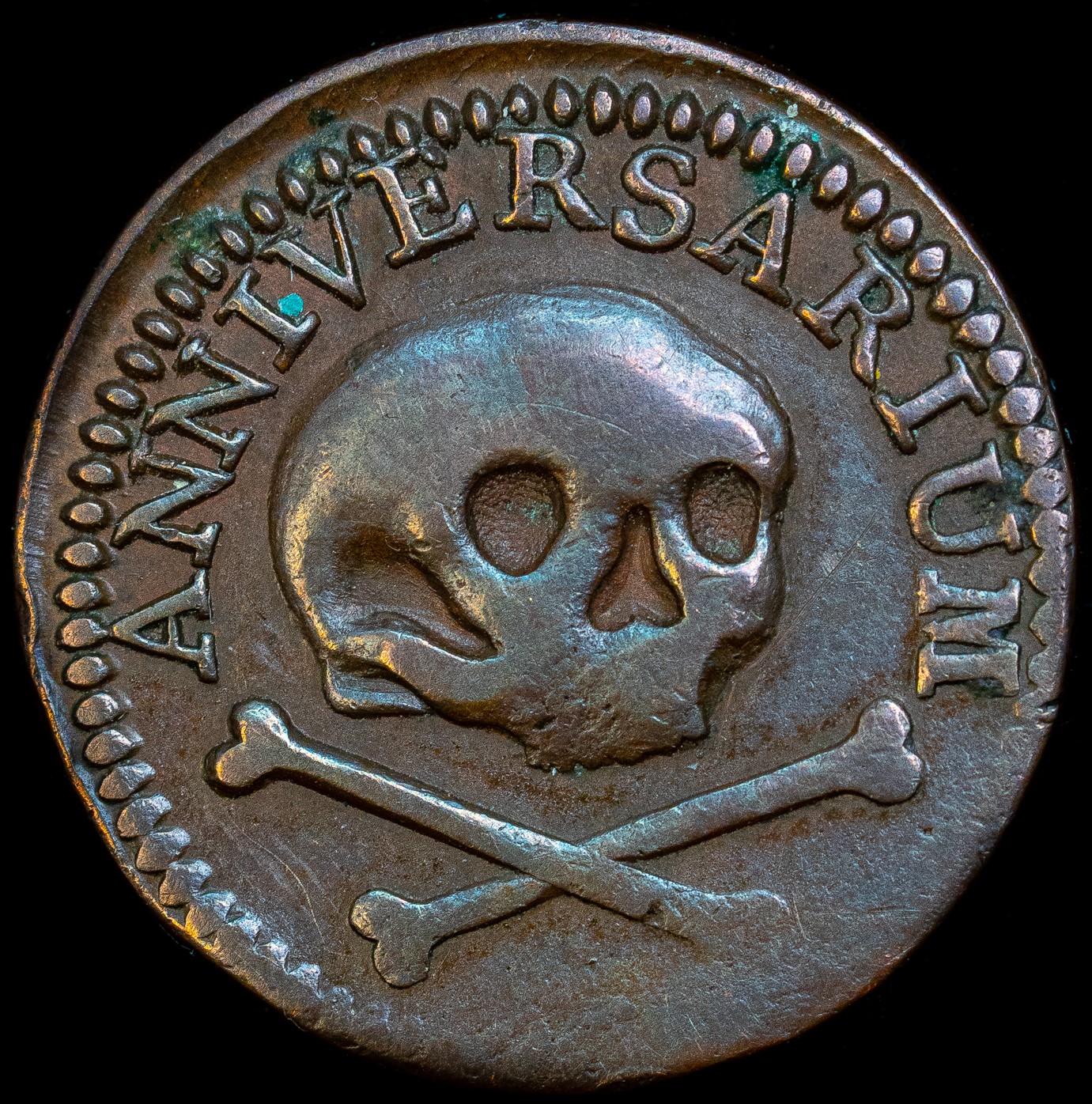
Leave a Reply